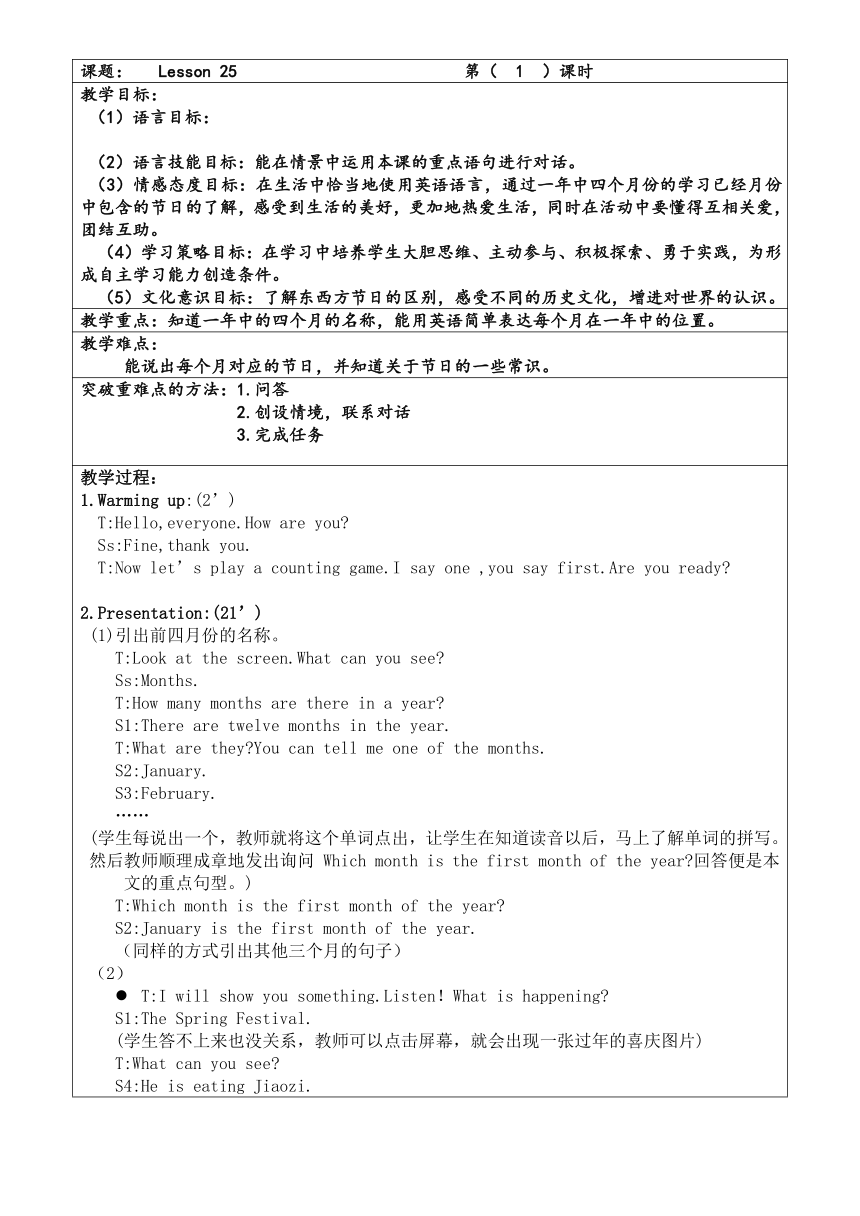Unit5 July is the seventh month.(Lesson25) 表格式教案
文档属性
| 名称 | Unit5 July is the seventh month.(Lesson25) 表格式教案 |  | |
| 格式 | doc | ||
| 文件大小 | 40.5KB | ||
| 资源类型 | 教案 | ||
| 版本资源 | 人教精通版(三年级起点) | ||
| 科目 | 英语 | ||
| 更新时间 | 2020-11-24 09:29:54 | ||
图片预览


文档简介
课题: Lesson 25 第( 1 )课时
教学目标: (1)语言目标:
(2)语言技能目标:能在情景中运用本课的重点语句进行对话。
(3)情感态度目标:在生活中恰当地使用英语语言,通过一年中四个月份的学习已经月份中包含的节日的了解,感受到生活的美好,更加地热爱生活,同时在活动中要懂得互相关爱,团结互助。
(4)学习策略目标:在学习中培养学生大胆思维、主动参与、积极探索、勇于实践,为形成自主学习能力创造条件。
(5)文化意识目标:了解东西方节日的区别,感受不同的历史文化,增进对世界的认识。
教学重点:知道一年中的四个月的名称,能用英语简单表达每个月在一年中的位置。
教学难点: 能说出每个月对应的节日,并知道关于节日的一些常识。
突破重难点的方法:1.问答 2.创设情境,联系对话
3.完成任务
教学过程: 1.Warming up:(2’)
T:Hello,everyone.How are you?
Ss:Fine,thank you.
T:Now let’s play a counting game.I say one ,you say first.Are you ready?
2.Presentation:(21’)
(1)引出前四月份的名称。
T:Look at the screen.What can you see?
Ss:Months.
T:How many months are there in a year?
S1:There are twelve months in the year.
T:What are they?You can tell me one of the months.
S2:January.
S3:February.
……
(学生每说出一个,教师就将这个单词点出,让学生在知道读音以后,马上了解单词的拼写。
然后教师顺理成章地发出询问 Which month is the first month of the year?回答便是本文的重点句型。)
T:Which month is the first month of the year?
S2:January is the first month of the year.
(同样的方式引出其他三个月的句子)
T:I will show you something.Listen!What is happening?
S1:The Spring Festival.
(学生答不上来也没关系,教师可以点击屏幕,就会出现一张过年的喜庆图片)
T:What can you see?
S4:He is eating Jiaozi.
S5:They are dancing.
S6:She is singsing.
T:The children are celebrating the Spring Festival.
When is it?
S6:In January./In February.
(展开二月的内容,教师领读,其中介绍“winter holiday”)
T:Do you know any other Festivals?
S1:New Year’s Day.
T:When?
S2:January 1st.
T:What do you do during New Year’s Day?
……
Look,the children are skating.
同样的方式引出March----Tree Planting Day,April----Easter.
3.Practice
(1)将提前准备好的表格发给孩子们,要求学生看课文的视频并且完成手中的表格。
(教师悄悄完整黑板上的表格,让学生恍然大悟,原来可以按照老师黑板上的进行填写。)
(2)展示在大屏幕上几个句子,让学生去进行小组讨论,完成句子。
(3)如果时间还有剩余,还可以介绍一下关于复活节的一些知识,由此引出今天的作业,学生选择自己喜欢的一个月份或者节日,去查阅资料并进行整理,下节课展示。
自己同桌起床的时间,以此练习 He/She gets up at 6:00.
(3)2’get home at 4:30/very late
在此阶段,根据两个已经展示的重点句型,学生对于这两个短语的句子已经可以顺畅地说出,所以时间上可以略短,可以只练习一两句第一人称,然后可以引入学生说说自己的家人——练习第三人称单数。
(4)4’接着让学生找出其他图片——go out,在这个图片上注明了时间,以引导学生说出准确的句子(I go out in the evening.)——以下给出了我预设的两种情况:
a: S3: I go out in the evening .
T:What about you?
S4:Me too.
T:Are you sure?I think it’s not very good for us to go out in the evening.
I don’t go out in the evening.
(还是先着重练习第一人称,然后等学生逐渐适应以后适时地问出What about your father/mother/sister/brother?引出“三单”形式,同时,学生在这个过程中会说出否定形式。对于这种生成,教师要知道适时地借助。)
b: S3:He doesn’t go out in the evening.
T:Me too. I don’t go out in the evening. I’m afraid of the dark.
(5)5’对于“go to the cinema”“go shopping”“stay up very late”以同样的对话的方式慢慢呈现,呈现以后紧跟着练习,让学生学一个,会一个,然后再进行下一个。
S1:I go to the cinema in the evening.
T:What about your sister?Does she like seeing films?
S1:Yes.She goes to the cinema in the afternoon.
Practice:
(1) Let’s have a look. Maybe this is Alice’s daily life.Can you introduce her daily life.3’
Eg.She gets up at 6 o’clock.She goes out in the afternoon…
(让大家用一个虚拟的人物练习如何介绍别人的日常生活,可以先是同桌练习,然后再上讲台向同学介绍一下)
(2)T:Next let's introduce my family.Look at this picture.This is my mother.She gets up very early.She likes jogging,it's good for her heath.She goes to work by bike and She gets home at six in the evening.
OK,now please talk about your family in groups.After two minutes,introduce her/him to us.
板书设计
教学目标: (1)语言目标:
(2)语言技能目标:能在情景中运用本课的重点语句进行对话。
(3)情感态度目标:在生活中恰当地使用英语语言,通过一年中四个月份的学习已经月份中包含的节日的了解,感受到生活的美好,更加地热爱生活,同时在活动中要懂得互相关爱,团结互助。
(4)学习策略目标:在学习中培养学生大胆思维、主动参与、积极探索、勇于实践,为形成自主学习能力创造条件。
(5)文化意识目标:了解东西方节日的区别,感受不同的历史文化,增进对世界的认识。
教学重点:知道一年中的四个月的名称,能用英语简单表达每个月在一年中的位置。
教学难点: 能说出每个月对应的节日,并知道关于节日的一些常识。
突破重难点的方法:1.问答 2.创设情境,联系对话
3.完成任务
教学过程: 1.Warming up:(2’)
T:Hello,everyone.How are you?
Ss:Fine,thank you.
T:Now let’s play a counting game.I say one ,you say first.Are you ready?
2.Presentation:(21’)
(1)引出前四月份的名称。
T:Look at the screen.What can you see?
Ss:Months.
T:How many months are there in a year?
S1:There are twelve months in the year.
T:What are they?You can tell me one of the months.
S2:January.
S3:February.
……
(学生每说出一个,教师就将这个单词点出,让学生在知道读音以后,马上了解单词的拼写。
然后教师顺理成章地发出询问 Which month is the first month of the year?回答便是本文的重点句型。)
T:Which month is the first month of the year?
S2:January is the first month of the year.
(同样的方式引出其他三个月的句子)
T:I will show you something.Listen!What is happening?
S1:The Spring Festival.
(学生答不上来也没关系,教师可以点击屏幕,就会出现一张过年的喜庆图片)
T:What can you see?
S4:He is eating Jiaozi.
S5:They are dancing.
S6:She is singsing.
T:The children are celebrating the Spring Festival.
When is it?
S6:In January./In February.
(展开二月的内容,教师领读,其中介绍“winter holiday”)
T:Do you know any other Festivals?
S1:New Year’s Day.
T:When?
S2:January 1st.
T:What do you do during New Year’s Day?
……
Look,the children are skating.
同样的方式引出March----Tree Planting Day,April----Easter.
3.Practice
(1)将提前准备好的表格发给孩子们,要求学生看课文的视频并且完成手中的表格。
(教师悄悄完整黑板上的表格,让学生恍然大悟,原来可以按照老师黑板上的进行填写。)
(2)展示在大屏幕上几个句子,让学生去进行小组讨论,完成句子。
(3)如果时间还有剩余,还可以介绍一下关于复活节的一些知识,由此引出今天的作业,学生选择自己喜欢的一个月份或者节日,去查阅资料并进行整理,下节课展示。
自己同桌起床的时间,以此练习 He/She gets up at 6:00.
(3)2’get home at 4:30/very late
在此阶段,根据两个已经展示的重点句型,学生对于这两个短语的句子已经可以顺畅地说出,所以时间上可以略短,可以只练习一两句第一人称,然后可以引入学生说说自己的家人——练习第三人称单数。
(4)4’接着让学生找出其他图片——go out,在这个图片上注明了时间,以引导学生说出准确的句子(I go out in the evening.)——以下给出了我预设的两种情况:
a: S3: I go out in the evening .
T:What about you?
S4:Me too.
T:Are you sure?I think it’s not very good for us to go out in the evening.
I don’t go out in the evening.
(还是先着重练习第一人称,然后等学生逐渐适应以后适时地问出What about your father/mother/sister/brother?引出“三单”形式,同时,学生在这个过程中会说出否定形式。对于这种生成,教师要知道适时地借助。)
b: S3:He doesn’t go out in the evening.
T:Me too. I don’t go out in the evening. I’m afraid of the dark.
(5)5’对于“go to the cinema”“go shopping”“stay up very late”以同样的对话的方式慢慢呈现,呈现以后紧跟着练习,让学生学一个,会一个,然后再进行下一个。
S1:I go to the cinema in the evening.
T:What about your sister?Does she like seeing films?
S1:Yes.She goes to the cinema in the afternoon.
Practice:
(1) Let’s have a look. Maybe this is Alice’s daily life.Can you introduce her daily life.3’
Eg.She gets up at 6 o’clock.She goes out in the afternoon…
(让大家用一个虚拟的人物练习如何介绍别人的日常生活,可以先是同桌练习,然后再上讲台向同学介绍一下)
(2)T:Next let's introduce my family.Look at this picture.This is my mother.She gets up very early.She likes jogging,it's good for her heath.She goes to work by bike and She gets home at six in the evening.
OK,now please talk about your family in groups.After two minutes,introduce her/him to us.
板书设计
同课章节目录
- Unit 1 I go to school at 8:00.
- Lesson 1
- Lesson 2
- Lesson 3
- Lesson 4
- Lesson 5
- Lesson 6
- Unit 2 What's your hobby?
- Lesson 7
- Lesson 8
- Lesson 9
- Lesson 10
- Lesson 11
- Lesson 12
- Unit 3 Would you like to come to my birthday party
- Lesson 13
- Lesson 14
- Lesson 15
- Lesson 16
- Lesson 17
- Lesson 18
- Fun Time 1
- Recycle 1
- Recycle 2
- Fun Reading
- Unit 4 January is the first month.
- Lesson 19
- Lesson 20
- Lesson 21
- Lesson 22
- Lesson 23
- Lesson 24
- Unit 5 July is the seventh month.
- Lesson 25
- Lesson 26
- Lesson 27
- Lesson 28
- Lesson 29
- Lesson 30
- Unit 6 There are four seasons in a year.
- Lesson 31
- Lesson 32
- Lesson 33
- Lesson 34
- Lesson 35
- Lesson 36
- Fun Time 2
- Recycle 1
- Recycle 2
- Fun Reading
